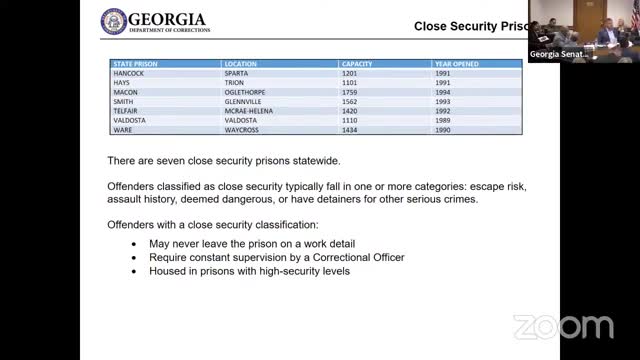Prisons Face Rising Threats from Drones and Cell Phones
August 24, 2024 | SENATE, Committees, Legislative, Georgia
This article was created by AI summarizing key points discussed. AI makes mistakes, so for full details and context, please refer to the video of the full meeting. Please report any errors so we can fix them. Report an error »

In a recent government meeting, officials addressed the escalating challenges posed by contraband cell phones and drones within state prisons, highlighting the urgent need for enhanced security measures. The discussions revealed that the presence of cell phones in prisons is not merely a communication issue but a significant threat, as they are often used to facilitate criminal activities both inside and outside prison walls. One official described contraband cell phones as \"deadly weapons,\" emphasizing their role in orchestrating drug trades and other illicit operations.
Drones emerged as a particularly pressing concern, with officials noting that criminals are increasingly using advanced technology to bypass security measures, including no-fly zones. Despite the implementation of drone detection systems at some facilities, the ongoing battle against drone incursions remains a daily struggle. Officials acknowledged that while state prisons lack the authority to jam cell phone signals—unlike federal prisons—efforts are underway to lobby federal agencies for the necessary permissions to enhance security.
The meeting also touched on the overall prison population in Georgia, which has remained relatively stable despite a significant increase in the state's population since 1985. Currently, the state houses approximately 49,000 inmates, a figure that officials attribute to various criminal justice reforms aimed at encouraging compliance with the law.
In addition to security concerns, the meeting addressed the management of female inmates, particularly those who are pregnant. Officials outlined the protocols in place for pregnant inmates, including prenatal care and postpartum support, which are facilitated through partnerships with healthcare providers. The discussion highlighted the unique challenges faced by female facilities, including the need for ongoing improvements to security and infrastructure as the population of female offenders continues to grow.
Overall, the meeting underscored the complexities of maintaining safety and security within the prison system, as officials continue to adapt to evolving threats and the changing demographics of the inmate population.
Drones emerged as a particularly pressing concern, with officials noting that criminals are increasingly using advanced technology to bypass security measures, including no-fly zones. Despite the implementation of drone detection systems at some facilities, the ongoing battle against drone incursions remains a daily struggle. Officials acknowledged that while state prisons lack the authority to jam cell phone signals—unlike federal prisons—efforts are underway to lobby federal agencies for the necessary permissions to enhance security.
The meeting also touched on the overall prison population in Georgia, which has remained relatively stable despite a significant increase in the state's population since 1985. Currently, the state houses approximately 49,000 inmates, a figure that officials attribute to various criminal justice reforms aimed at encouraging compliance with the law.
In addition to security concerns, the meeting addressed the management of female inmates, particularly those who are pregnant. Officials outlined the protocols in place for pregnant inmates, including prenatal care and postpartum support, which are facilitated through partnerships with healthcare providers. The discussion highlighted the unique challenges faced by female facilities, including the need for ongoing improvements to security and infrastructure as the population of female offenders continues to grow.
Overall, the meeting underscored the complexities of maintaining safety and security within the prison system, as officials continue to adapt to evolving threats and the changing demographics of the inmate population.
View full meeting
This article is based on a recent meeting—watch the full video and explore the complete transcript for deeper insights into the discussion.
View full meeting
